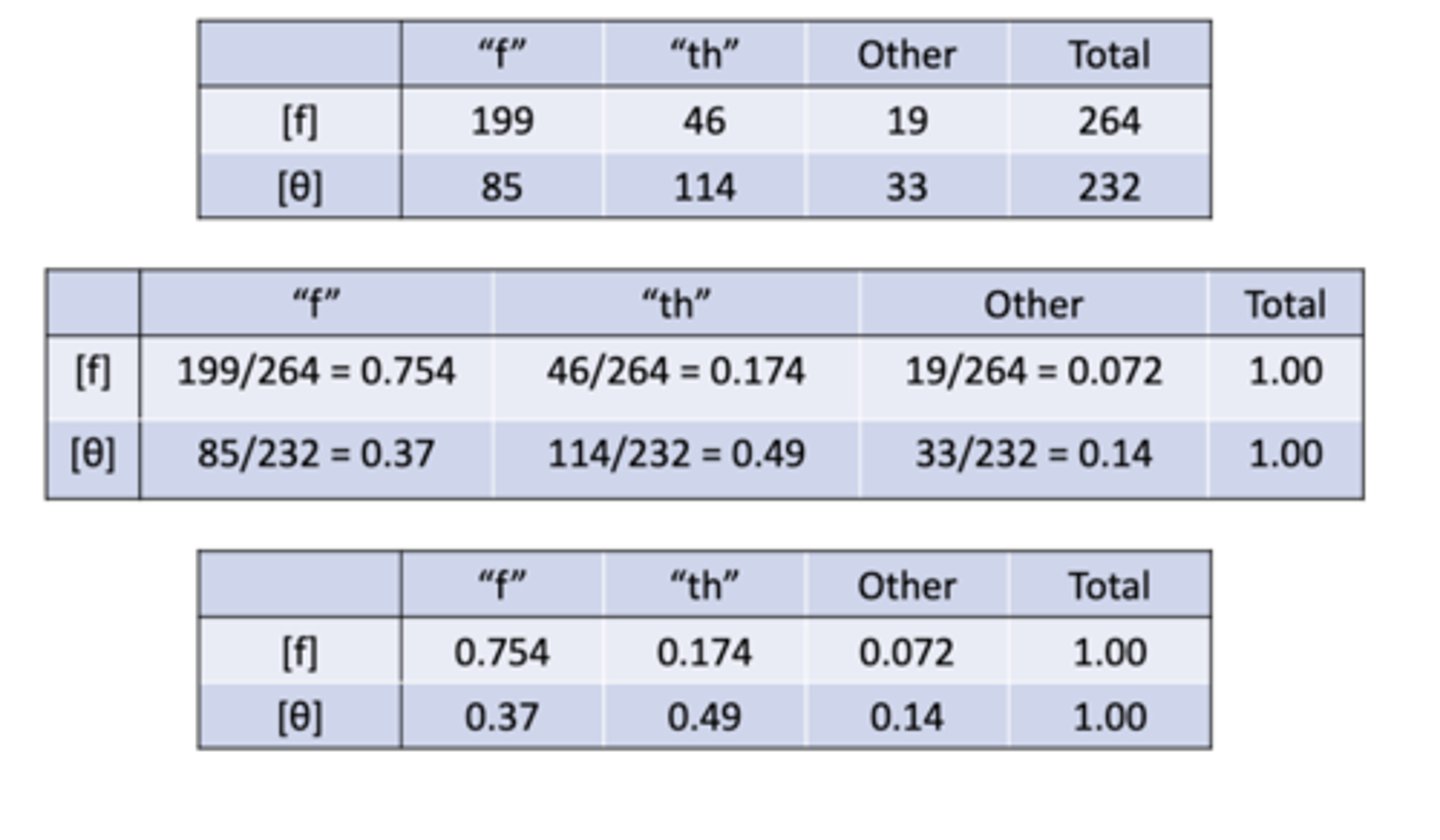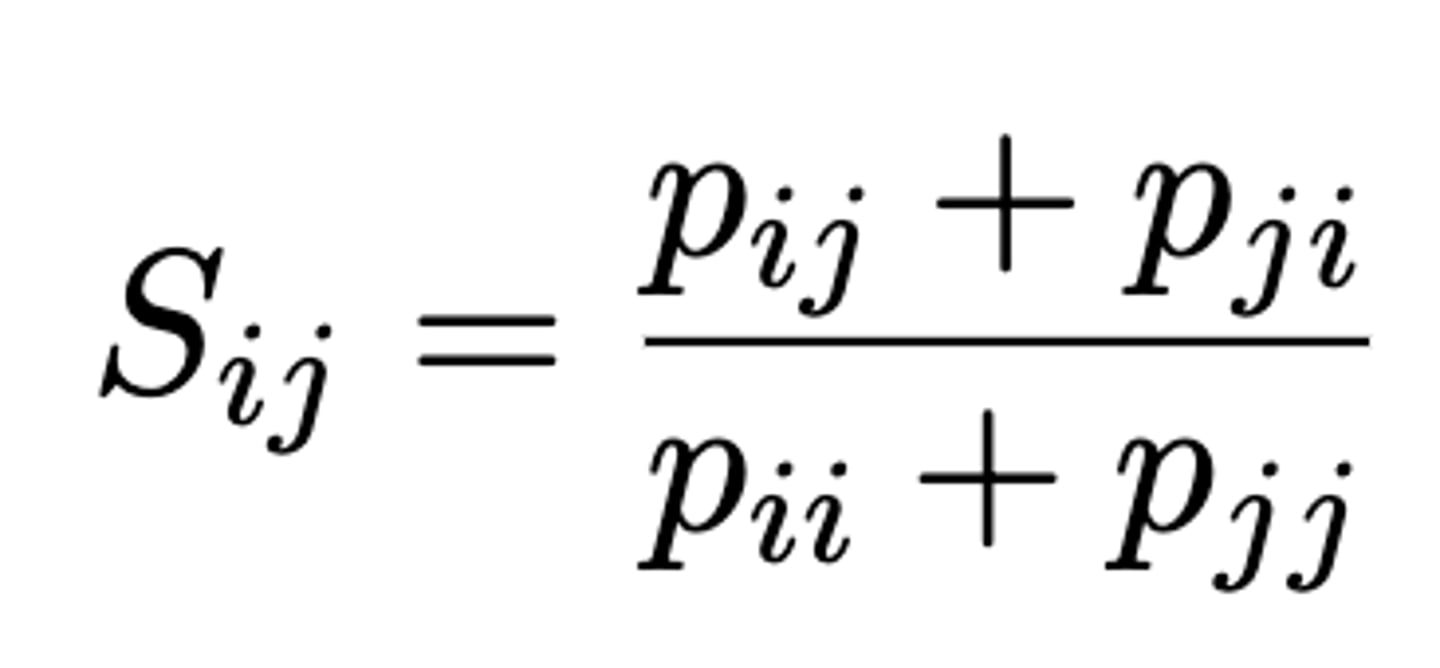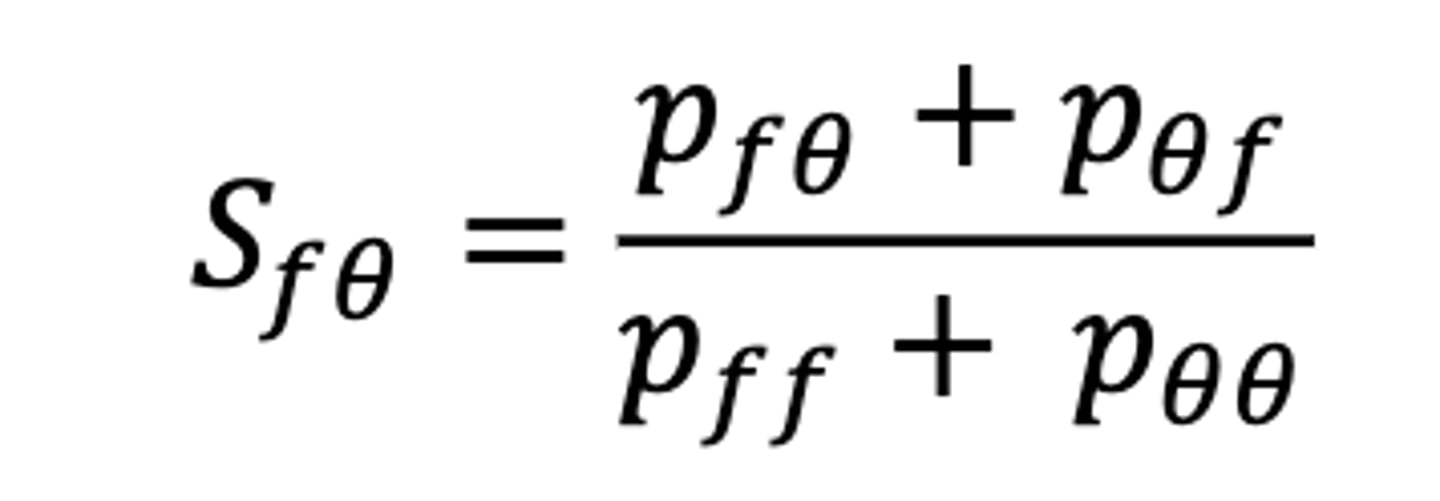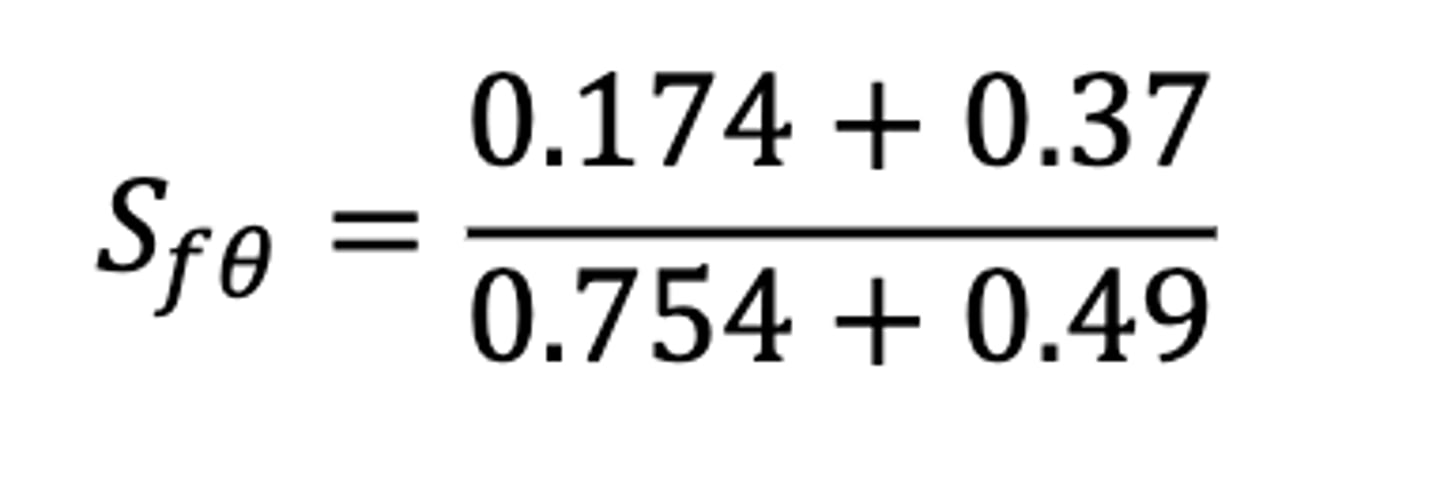Perceptual Similarity and distance CGSC433
1/85
There's no tags or description
Looks like no tags are added yet.
Name | Mastery | Learn | Test | Matching | Spaced |
|---|
No study sessions yet.
86 Terms
when speech sounds differ from one another in more than 1 acoustic dimension
may be more useful to express confusion rate with perceptual similarity
the perceptual similarity between speech sounds can be
measured
these speech sounds can be put on a
map
sounds closer together are
perceptually more similar
sounds farther apart are
perceptually more distinct
English fricative perception Miller and Nicely 1955
subjects are played [f] and [θ] and asked to identify the sounds as "f" or "th"
![<p>subjects are played [f] and [θ] and asked to identify the sounds as "f" or "th"</p>](https://knowt-user-attachments.s3.amazonaws.com/9dc1c41a-02d8-472e-b5a3-f06080a077b3.jpg)
when investigating speech sounds that differ along multiple (unknown) dimensions
the "confusion scores" give us a way to think about their similarity
when one sound is easily confused with another
we can think of the two sounds as being close together in perceptual space, they are similar
when one sound is not easily confused with another
we can think of the two sounds as being far apart in perceptual space, not similar
these ideas can be made precise with statistical techniques called
Multidimensional scaling (MDS) which is like triangulation, and clustering analyses
essentially multidimensional scaling allows us to
draw a perceptual map in n dimensions where n is any number
we usually use
2 dimensions, so we can see it easily and then we can try to interpret these dimensions
when we make maps, we need to find a way for
all the distances to get along. This is MDS

represent perceptual differences between
stimuli as ratio/proportion
estimate
perceptual distance- confusability plus "Shepard's Law"
pin down points in the space with
multidimensional scaling (MDS)
English fricative perception Miller and Nicely data expressed as ratios

calculating proportions from raw data- English fricative perception Miller and Nicely

1st step in finding perceptual distance
determine similarity of these pairs with this equation

S=
similarity
P=
proportion
I and j are
variables representing two sounds under comparison
confusability of [f] with [θ]

confusability of [f] and [θ] continued

confusability of [f] and [θ] answer

S=1 means
exactly the same
S=0 means
totally different
if 2 sounds are exactly the same S=1
perceptual distance should be zero-Shepard's law
if 2 sounds are completely different S=0
perceptual distance should be very large-Shepard's law
perceptual distance is
negative natural log (ln) of similarity: d=-ln(S)
perceptual distance in [f] and [θ]

do all humans perceive speech the same way, regardless of their native language?
no, our own language also affects the way we perceive individual speech sounds
speakers of different languages have
different perceptual maps of the same sounds
perceptual vowel space is similar to
acoustic vowel space
pure auditory differences
matter in all languages
perception of speech can be affected by both
auditory ability and our own language experience
phonetic coherence refers to
our ability to force incoherent signals into a unifying picture--> one example duplex perception
people not only hear the chirp but they also perceive
what is heard from the right ear as [da] or [ga]- the missing piece has been filled in by the ear
people also rely on
visual signals when perceiving speech- example-McGurk effect
McGurk
an error in perception that occurs when we misperceive sounds because the audio and visual parts of the speech are mismatched.
for people who aren't sensitive to the McGurk effect could be for a variety of reasons including
some people are more sensitive to auditory cues than visual cues, bilingualism or learning a second language can change sensory perception
bilinguals experience McGurk effect more than
monolinguals
multisensory speech perception- somatosensation
tactile sensation- in one experiment people heard a syllable starting with either a voiced or voiceless stop, on some trails they also received a puff of air on their hand or neck, speech was presented in masking noise to reduce overall accuracy
the ganong effect
one where your lexical knowledge (the list of words you know) affects your speech perception
more people say they hear dog than gog because
dog is a real word and gog isn't
the real word acts as
a perceptual magnet compared to the non-word
speech perception is more than
acoustic analysis of speech signal, matching analysis with a string of phonemes, putting phoneme string together, identifying word that matches sound sequence, top down processing
lexical knowledge-top down processing helps with
phonetic coherence
sound missing from a speech signal can be
restored by brain and may disappear to be heard
[s] is perceived even when its not there due to
knowledge of word legislation
speech replaced with
3 sine waves that vary in frequency through time
strong evidence that we use knowledge of our own language to
understand speech-top down processing
factors affecting speech perception include
auditory ability, phonetic knowledge, our own language experiences, visual/other sensory cues
despite the great variety of different speakers, different conditions, and coarticulation involved in speech (known as the lack of invariance problem)
listeners perceive vowels and consonants as constant categories
two different approaches
motor theory of speech perception (Liberman et al. 1967, Liberman and Mattingly, 1985) and general auditory approach
motor theory of speech perception basis
relation of phoneme to acoustic is context-dependent
lack of invariance problem
variability problem
general audition and learning cannot account for
uniqueness of human ability to perceive speech, speech-specific linguistic module is needed, speech motor system could provide this
internal synthesizer
mappings between intended articulators/motor commands and acoustic consequences
listeners use the acoustic signal and knowledge of these mappings to
determine intended articulatory gestures of the speaker
speech is understood in terms of
how it is produced
modified--> hypothesized that
articulatory events recovered by human listeners are neuromotor commands to the articulators, rather than actual articulatory movements or gestures
according to the motor theory of speech perception
human ability to perceive speech sounds is special and can't be attributed to general mechanisms of audition and perceptual learning
perception thought to depend on
a specialized decoder or module that is speech-specific, unique to humans, and innately organized as part of human specialization for language
a major benefit of motor theory of speech production
perception and production governed by the same types of units/mechanisms
support for the motor theory of speech perception comes from
McGurk effect-where visual cues of articulation seem to have an effect on the listeners perception of the sound, duplex perception, and speech shadowing was shown to be faster after hearing spoken words
general auditory approaches
acoustic events are the objects of perception
general auditory approaches have
no special-speech module: perception uses the same perceptual systems and learning mechanisms that other animals have
general auditory approach is a term coined by
Diehl and colleagues to describe non-motor alternatives
GAA say context dependence of acoustics is
not a problem: listeners make use of multiple cues and can interpret with acoustic context
support for general auditory approaches
lack of acoustic invariance is not problematic, categorical perception- synthetic sounds can be perceived categorically and non-human animals exhibit categorical perception
drawbacks against general auditory approaches
would be surprising is there were not processes and resources devoted to the perception of speech
research actually supports a special status for speech in auditory perception
evidence suggests that human neonates prefer sounds of speech to non-speech
adults are able to distinguish speech from non-speech based on
visual cues alone
infants 4-6 months can
detect based on visual cues alone, when a speaker changes from one language to another, though all but those in bilingual households lost that ability by 8 months
perceptual judgements by clinicians and even family members of a client play
a major role in understanding diagnosis and management of the disorder
it also matters from the client/patient standpoint
what they can perceive when they have particular communication/hearing disorders
ataxic dysarthria
associated with cerebellar disorders, involves irregular or slow rhythm of speech, with pauses and abrupt explosions of sound and abnormal or excessively equal stress on every syllable
a feature of ataxic dysarthria is
inability to regulate long-short-long-short patterning of syllable durations in multi-syllabic utterance
normal listeners will have trouble
identifying word onset locations in speech of someone with ataxic dysarthria
SLPs understanding of
link between neural disease, speech timing problems, and lexical access as an important part of speech perception is crucial which allows more effective intervention on speech timing issue to benefit both speaker and listener
standardized articulation tests evaluate
goodness of consonant production in word-initial, medial, and final positions such as /s/ in sock, messy, and bus
listeners rely mostly on
word-initial consonants for word identification in continuous speech
audiometric testing
identification of frequencies of hearing loss
significant hearing loss in higher frequencies 4,000-8,000 Hz compared with
lower frequencies 250-2,000 Hz will likely affect processing of sounds like /s/, /ʃ/, and /t/
knowledge of speech perception is important for
matching amplification characteristics of hearing aids to hearing loss patterns across frequency spectrum